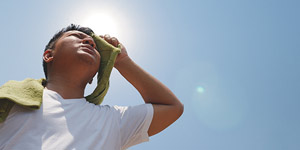Heat Stroke Treatment Clinic in Columbia MD
The most serious heat-related sickness is heat stroke. It occurs when the body’s temperature can no longer be controlled: the body’s temperature rises quickly, the sweating process fails, and the body is unable to cool down. When heat stroke occurs, the body temperature can quickly climb to 106°F or higher. Intense sweating, cold, pale, and clammy skin, a quick, weak pulse, nausea or vomiting, muscle cramps, weariness or weakness, dizziness, and headache are the most common symptoms. Visit our experienced team at Elite Urgent Care for effective treatment. We are conveniently located at 6100 Dobbin Rd, Suite A Columbia, MD 21045. For more information, contact us today or book an appointment online.


Table of Contents:
Heat stroke:
What should we do if we do have some or all of these symptoms following being outside in a hot and humid day?
Treatment of heat stroke:
As we have more hot and humid days, we should be careful regarding heat stroke which can happen especially in elderly people, children, babies, and people with heart, kidney, and other medical issues.
Heat stroke is a condition in which the body’s temperature will increase to high levels and the person’s body will get too hot. The core body temperature may increase to 104–105 °F or higher. This condition may happen in adults and middle-aged people following doing heavy exercise in hot and humid weather and might be with low or not enough intake of water and fluids. It can happen without exercise mostly in people who have health issues, the elderly population, children, and babies. So, we should be very careful during hot and humid days to prevent this condition which is an emergency issue. As it was mentioned, it can lead to serious medical conditions and even death if not treated as soon as possible. Thus, having some information regarding the prevention and management of this emergency will be very helpful.
Symptoms of heat stroke:
• Heat stroke may cause a variety of symptoms including but not limited to:
• Increasing core body temperature to 104-105 or higher
• Fast breathing and fast heart rate
• Skin redness, and sometimes skin rash in addition skin might feel moist or dry
• Nausea, vomiting, diarrhea
• Muscle cramps or muscle weakness
• Trouble thinking clearly
• Trouble walking
• Passing out or seizures
• Headache and confusion
We must know that this is an emergency and we should get medical support as soon as possible. So, we should call 911 right away.
In the Hospital or clinic setting, you will be evaluated based on your body temperature, and clinical symptoms, and you may need to have more evaluation including blood tests, urine tests, EKG, etc to evaluate any acute consequences of heat stroke on your body. The main treatment will be focused on cooling the core body temperature as soon as possible. This can be done in different ways including pouring cold water on the body surface, using a fan over the wet skin, putting the patient on an ice bath, oral cold fluids, and IV fluid as well if indicated. Treatment of any other problem due to heat stroke will be done as well.
Prevention of heat stroke:
• Avoid being outside for long times during hot and humid days, especially for elderly people, children, and people with health issues.
• Drink as much as fluid during exercise in summertime
• Avoid being in a hot environment such as in a hot car for a long time
• Try to take care of your increasing body temperature before getting too hot
• Do not wear too many layers during exercise or being outside on humid and hot days
• Watch early symptoms of heat stroke like feeling hot, tired, or thirsty, headache, nausea, or vomiting.
If any of the above symptoms you should try to cool your body by pouring cold water and putting a cold pack on the neck, armpit, and groin area.








